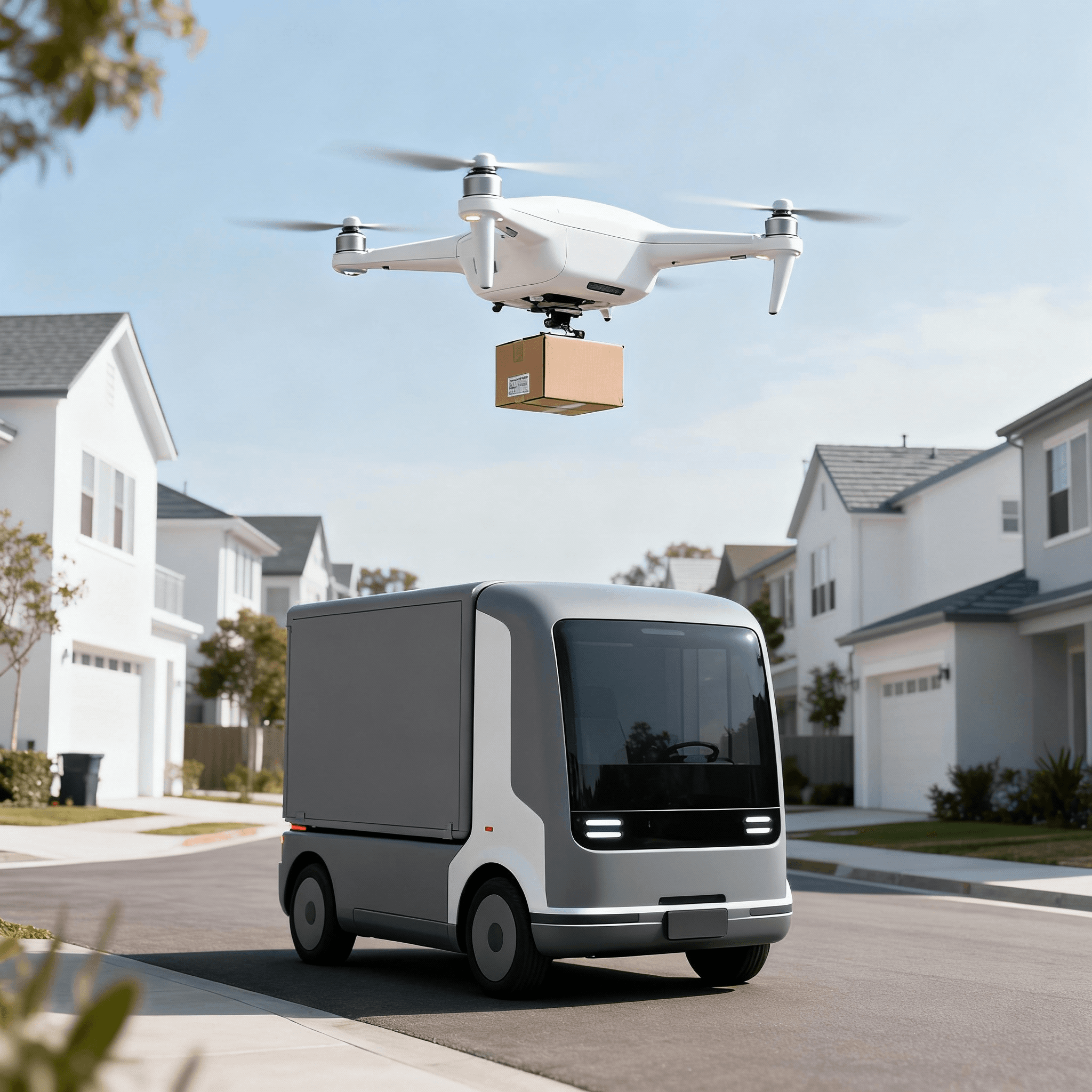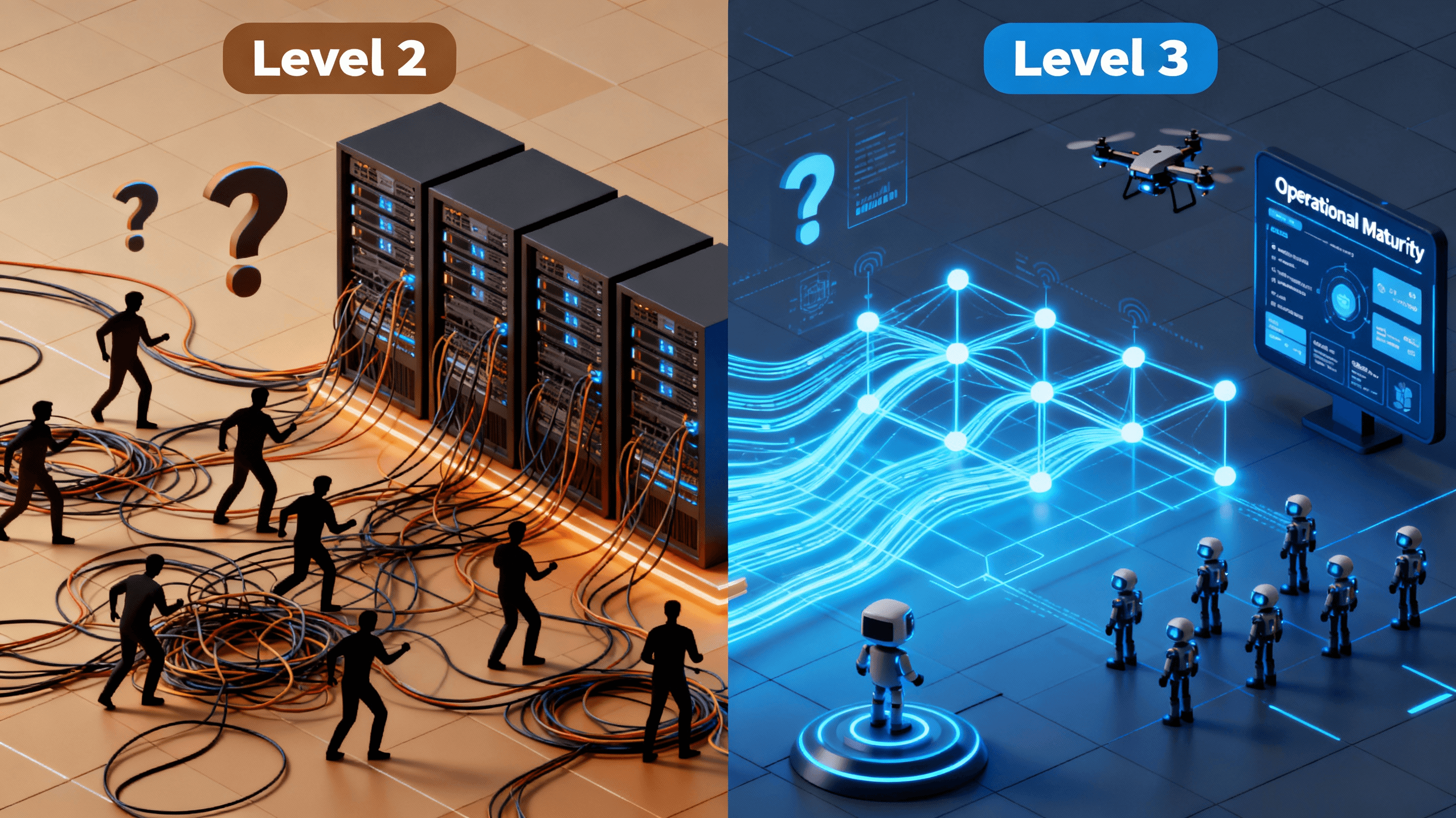How AI is Making Last-Mile Delivery More Efficient
Monday, 29 Sep 2025
|
How AI is Making Last-Mile Delivery More Efficient
Last-mile delivery—the final journey from distribution center to customer doorstep—represents logistics' most expensive and complex challenge. Accounting for over 50% of total shipping costs while demanding speed, accuracy, and flexibility that strain traditional operations, this final segment determines whether businesses profit or hemorrhage money.
Customer expectations compound the challenge: 88% of consumers now expect same-day or next-day delivery, while 69% are less likely to shop with retailers after a poor delivery experience. Traditional routing and planning methods simply cannot balance these competing demands for speed, cost-efficiency, and reliability.
AI is fundamentally transforming this equation. Organizations implementing AI-powered last-mile optimization report 25-35% cost reductions, 90-95% on-time delivery rates, and the ability to scale delivery capacity without proportional cost increases. For logistics leaders, understanding how AI solves the last-mile puzzle isn't optional—it's essential for competitive survival.
Wondering why last-mile delivery remains so expensive despite decades of optimization attempts? The answer lies in complexity that exceeds human planning capabilities—but not AI's.
The Last-Mile Challenge: Why It's So Expensive
Last-mile delivery faces unique challenges that make it disproportionately costly:
Geographic Dispersion: Unlike linehaul shipping with consolidated loads between fixed points, last-mile delivers individual packages to thousands of dispersed addresses
Low Stop Density: Residential deliveries require vehicles to cover large areas with relatively few stops per mile
Time Windows: Customer availability constraints and delivery promises create rigid scheduling requirements
Failed Deliveries: Missed deliveries requiring re-attempts can double costs for affected packages
Traffic and Congestion: Urban deliveries face unpredictable delays in dense traffic
Customer Service Complexity: Individual customer interactions, delivery instructions, and communication requirements add overhead
Traditional approaches using fixed routes or basic optimization software cannot dynamically adapt to these complexities, resulting in inefficient routing, wasted fuel, and poor resource utilization.
For context on how AI differs fundamentally from traditional optimization, explore A Simple Analogy for How AI Optimizes a Supply Chain.
How AI Transforms Last-Mile Efficiency
1. Dynamic Route Optimization in Real-Time
The most impactful AI application in last-mile delivery is intelligent route optimization that adapts continuously to changing conditions.
How AI-powered routing works:
- Multi-factor analysis: Simultaneously processes traffic patterns, weather conditions, delivery time windows, vehicle capacity, driver schedules, and historical performance data
- Real-time adaptation: Continuously recalculates optimal routes as conditions change—traffic jams, cancelled orders, priority shifts
- Learning algorithms: Improves routing decisions over time by analyzing outcomes from millions of past deliveries
- Constraint handling: Balances competing objectives (minimize cost, maximize on-time delivery, reduce emissions) while respecting hard constraints
Business impact:
- 20-30% reduction in fuel costs through optimized routing
- 25-40% increase in stops per route improving driver productivity
- 15-25% decrease in total miles driven reducing vehicle wear and emissions
- 90-95% on-time delivery rates improving customer satisfaction
Example: UPS's ORION system, powered by AI route optimization, saves 100 million miles and 10 million gallons of fuel annually while improving delivery performance.
Discover the algorithms powering these capabilities in Most Common AI Algorithms Used for Route Planning and Demand Forecasting.
2. Predictive Demand Forecasting for Resource Optimization
AI forecasting enables proactive capacity planning and resource allocation before demand materializes.
Predictive capabilities:
- Volume forecasting: Predicts delivery volumes by geography, day, and time with high accuracy
- Demand pattern recognition: Identifies recurring patterns (weekday vs. weekend, seasonal fluctuations, promotional spikes)
- Anomaly detection: Flags unexpected demand changes requiring immediate response
- Capacity planning: Optimizes driver scheduling, vehicle allocation, and warehouse staffing proactively
Business outcomes:
- 10-20% reduction in inventory costs through precise demand prediction
- 30% improvement in resource utilization matching capacity to predicted demand
- Reduced emergency costs from last-minute capacity scrambles
- Better vendor negotiations through data-driven volume forecasts
Learn more about AI forecasting accuracy in How AI Improves the Accuracy of Demand Forecasting.
3. Autonomous Delivery Vehicles (ADVs)
Perhaps the most transformative development, autonomous delivery robots and drones eliminate driver costs while enabling 24/7 operations.
Autonomous delivery technologies:
Ground-based robots: Small autonomous robots navigating sidewalks for local deliveries
- Companies like Starship Technologies deploy thousands of robots delivering groceries, food, and packages
- Cost per delivery: $1-2 vs. $5-8 for human drivers
- Operating 24/7 without breaks or overtime
Delivery drones: Aerial vehicles for rapid lightweight deliveries
- Amazon Prime Air testing drone delivery completing orders in 30 minutes
- Can reach remote areas inaccessible or expensive for ground vehicles
- MIT research shows drones can predict fuel levels and sensor conditions to optimize mission success
Autonomous vans: Self-driving delivery vehicles for larger payloads
- Companies like Nuro and Waymo testing autonomous delivery vans
- Eliminate driver labor costs (typically 50-60% of last-mile expenses)
- Consistent driving patterns reduce maintenance costs by 20-30%
Projected impact: Transforma Insights estimates 4.7 million delivery robots in operation by 2032, fundamentally reshaping last-mile economics.
Explore related warehouse automation in How Robots and AI Are Transforming Warehouse Operations.
4. Real-Time Tracking and Proactive Exception Management
AI-powered tracking systems provide customers with accurate ETAs while enabling proactive problem resolution.
Intelligent tracking features:
- Predictive ETAs: AI analyzes current progress, traffic, and remaining stops to calculate accurate delivery windows
- Proactive delay notifications: Automatically alerts customers before delays occur, not after
- Exception detection: Flags potential issues (address problems, access restrictions, weather delays) before delivery attempts
- Dynamic rerouting: Automatically adjusts routes when delays threaten on-time performance
Customer experience impact:
- 40% reduction in "Where is my order?" inquiries through proactive communication
- 25% decrease in failed deliveries by addressing access issues before arrival
- Improved satisfaction scores as customers receive realistic, accurate delivery windows
5. AI-Powered Fleet Management
Intelligent fleet management optimizes vehicle utilization, maintenance, and driver productivity.
Optimization areas:
- Vehicle assignment: Matches delivery requirements to optimal vehicle types (cargo capacity, refrigeration, etc.)
- Predictive maintenance: Detects potential vehicle issues before breakdowns occur
- Driver performance: Identifies coaching opportunities and recognizes top performers
- Fuel optimization: Monitors driving behaviors and recommends efficiency improvements
Operational benefits:
- 15-20% improvement in vehicle utilization rates
- 20-30% reduction in unplanned maintenance costs
- 10-15% fuel savings through optimized driving behaviors
6. Intelligent Customer Communication
NLP-powered chatbots and virtual assistants handle customer inquiries, delivery scheduling, and issue resolution automatically.
Automated communication:
- Real-time delivery status updates via SMS, email, or app notifications
- AI chatbots answering tracking inquiries 24/7 in multiple languages
- Intelligent rescheduling accommodating customer preferences automatically
- Proactive problem resolution before customers need to contact support
Learn more about NLP applications in How Natural Language Processing (NLP) Applies to the Logistics Industry.
Real-World Last-Mile AI Success Stories
Amazon: End-to-End AI Optimization
Amazon's delivery network represents the most comprehensive AI deployment in last-mile logistics:
- AI route optimization across 200+ fulfillment centers
- Predictive demand placement positioning inventory near anticipated customers before orders
- Scout robots for autonomous neighborhood deliveries
- Prime Air drones testing aerial delivery for 30-minute fulfillment
- Dynamic pricing for delivery speed options based on capacity
Results: 10% efficiency improvement through DeepFleet AI system, enabling same-day delivery expansion to millions more customers.
FedEx: Predictive Logistics Platform
FedEx's AI platform predicts potential delays 48-72 hours before they occur, enabling proactive rerouting:
- Deep learning models analyzing weather, traffic, and operational patterns
- Automated rerouting decisions executed without human intervention
- Customer notification systems alerting to delays before they impact delivery
Impact: 20% improvement in on-time delivery performance in optimized corridors.
Explore broader control tower capabilities in What is an AI-Powered Control Tower in Logistics?.
Measurable Cost Reductions from AI
Organizations implementing comprehensive AI last-mile solutions report consistent improvements:
Direct Cost Savings
- 25-35% reduction in last-mile delivery costs
- 20-30% decrease in fuel consumption
- 15-25% lower vehicle maintenance expenses
- 30-50% reduction in customer service costs through automation
Operational Efficiency
- 40% improvement in driver productivity (stops per shift)
- 70% reduction in manual planning time
- 50% decrease in failed delivery attempts
- Real-time visibility eliminating status inquiry overhead
Customer Experience
- 90-95% on-time delivery performance
- 60% reduction in delivery-related complaints
- 25-40% improvement in customer satisfaction scores
- Higher repeat purchase rates from superior delivery experience
How debales.ai Optimizes Last-Mile Delivery
At debales.ai, our AI platform delivers comprehensive last-mile optimization capabilities:
Intelligent Route Optimization: Dynamic multi-stop routing considering real-time traffic, weather, and delivery constraints
Predictive Demand Forecasting: Accurate volume prediction enabling proactive capacity planning and resource allocation
Automated Communication: AI-powered customer notifications, chatbots, and exception handling
Fleet Intelligence: Predictive maintenance, driver performance analytics, and vehicle utilization optimization
Seamless Integration: Connects with existing TMS, dispatch systems, and customer communication platforms
Explainable AI: Transparent reasoning showing why routing decisions are made and what factors drive recommendations
Our approach combines routing intelligence with the predictive capabilities detailed in How Predictive Analytics Works for Logistics.
Implementation Roadmap for AI Last-Mile Optimization
Successful implementations follow structured approaches:
Phase 1: Assessment and Planning
- Analyze current last-mile costs, performance, and pain points
- Identify high-impact optimization opportunities
- Establish baseline metrics for ROI measurement
Phase 2: Data Integration
- Connect routing, vehicle, driver, and customer data sources
- Ensure data quality and completeness
- Integrate external data feeds (traffic, weather)
Phase 3: Pilot Implementation
- Deploy AI optimization in limited geography or customer segment
- Monitor performance against baseline metrics
- Refine algorithms based on real-world results
Phase 4: Scale and Optimize
- Expand AI deployment across full delivery network
- Continuously improve through machine learning
- Add advanced features (predictive analytics, autonomous vehicles)
The Future: Fully Autonomous Last-Mile Networks
The trajectory points toward completely autonomous last-mile delivery networks combining ground robots, aerial drones, and self-driving vehicles:
Emerging capabilities:
- Drone delivery from micro-fulfillment centers to homes within minutes
- Autonomous robot swarms coordinating multi-stop neighborhood deliveries
- Self-learning systems continuously optimizing based on billions of deliveries
- Integrated urban logistics platforms coordinating across multiple carriers
This vision aligns with the digital twin concept explored in What is a Digital Twin and How is it Used in Logistics AI?.
Strategic Imperative: Acting on Last-Mile AI
With last-mile representing 50%+ of total logistics costs, even modest AI-driven improvements deliver outsized financial impact. Organizations delaying AI adoption face widening cost disadvantages against competitors achieving 25-35% efficiency gains.
The last-mile challenge isn't getting easier—customer expectations continue rising while margins compress. AI isn't just an optimization tool; it's the difference between profitable growth and unsustainable cost structures.
Ready to transform last-mile delivery from your biggest cost center into competitive advantage?
Discover how debales.ai's AI-powered platform delivers industry-leading last-mile efficiency through intelligent routing, predictive analytics, and automated optimization—reducing costs while delighting customers.
Book a demo with debales.ai today and experience how AI solves the last-mile challenge with measurable results.
All blog posts
View All →
Friday, 28 Nov 2025
The 90-Day Roadmap: Moving from Ad-Hoc AI to Operational Excellence
Stuck in AI experimentation? Learn how to escape Level 2 maturity using the Mess-O-Meter to diagnose chaos, prioritize with triangulation, and scale in 90 days.

Thursday, 27 Nov 2025
Mess-O-Meter Deep Dive: Real Logistics Examples for Digital Maturity
Discover Mess-O-Meter examples diagnosing digital chaos in logistics—baseline workflows, benchmark maturity, create AI roadmaps with real steps for transformation success.

Wednesday, 26 Nov 2025
Multi-Agent AI via Email: End-to-End Automation for Logistics Complexity
Explore agentic orchestration where autonomous email AI agents coordinate freight, customs, insurance, and carriers—automating multi-party processes for resilient supply chains.